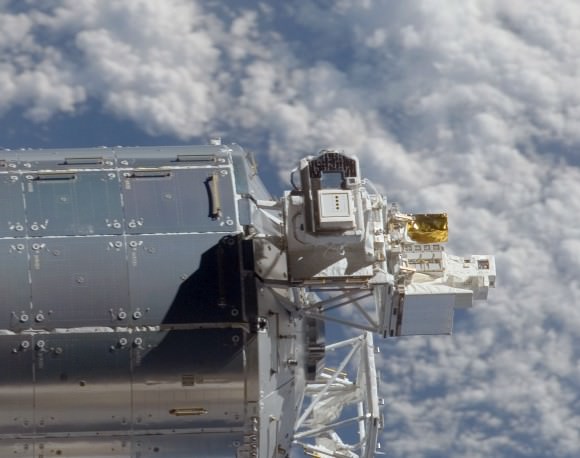This weekend the International Space Station will turn itself to face the Sun, enabling ESA’s SOLAR instrument to capture an entire rotation of the solar surface. This is the first time the Station has changed attitude for scientific reasons alone.
This instrument has been on the ISS since 2008, and for the first time will record a full rotation of the Sun. It began this effort on November 19, 2012, and on December 1, the Station will spend two hours turning about 7 degrees so that observations can continue. It will hold this angle for ten days before returning to its original attitude.
“We want to record a complete rotation of the Sun and that takes around 25 days,” said Nadia This, operations engineer at the Belgian User Support and Operations Centre that controls SOLAR.
SOLAR needs to be in direct view of the Sun to take measurements but the Space Station’s normal orbit obscures the view for two weeks every month.
All the international partners had to agree on changing the ISS’s orientation.
However, moving a 450-ton orbital outpost the size of a city block isn’t a simple undertaking. Aside from calculating the correct orbit to keep SOLAR in view of the Sun, other factors need to be taken into account such as ensuring the solar panels that power the Station also face the Sun. Additionally, communication antennas need to be reoriented to stay in contact with Earth and other scientific experiments must be adjusted.
The SOLAR instrument located on the exterior of the Columbus module on the ISS. Credit: ESA
The SOLAR instrument was originally designed to last about 18 months, but has been going strong for 5 years. It is installed on the outside of the ESA’s Columbus module.
The SOLAR payload consists of three instruments to the solar spectral irradiance throughout virtually the whole electromagnetic spectrum.
The three complementary solar science instruments are:
SOVIM (SOlar Variable and Irradiance Monitor), which covers near-UV, visible and thermal regions of the spectrum.
SOLSPEC (SOLar SPECctral Irradiance measurements) covers the 180 nm – 3 000 nm range.
SOL-ACES (SOLar Auto-Calibrating Extreme UV/UV Spectrophotometers) measures the EUV/UV spectral regime.
Scientists say SOLAR’s observations are improving our understanding of the Sun and allowing scientists to create accurate computer models and predict its behavior.
Source: ESA



This data will couple with SDO and Stereo mission data quite nicely! The timing couldn’t be better… here comes Solar Max.!
What I wonder: Aren’t those dedicated satellites you mention (SDO, STEREO, …) better equipped to these kinds of measurements?
The maneuver actually occurred on Friday the 30th, not Saturday